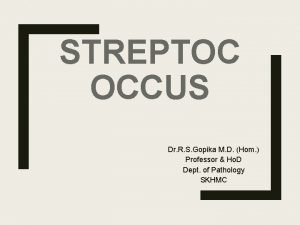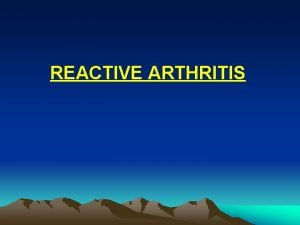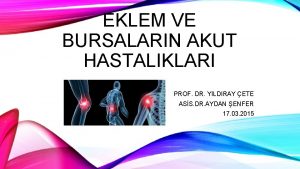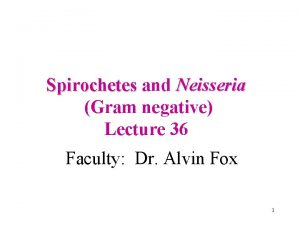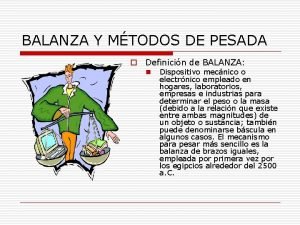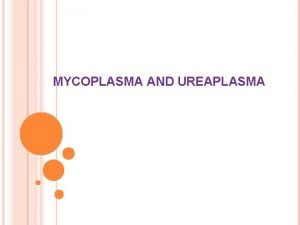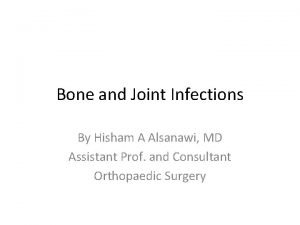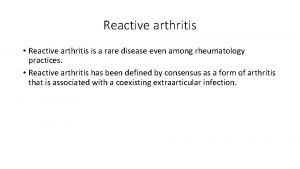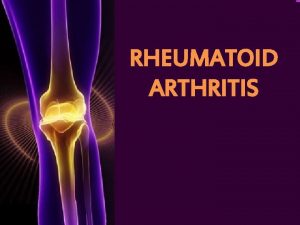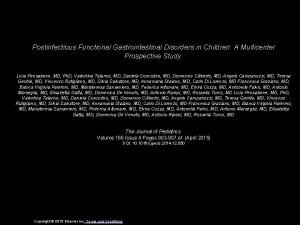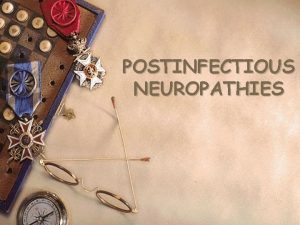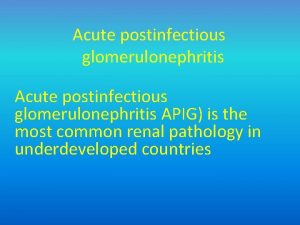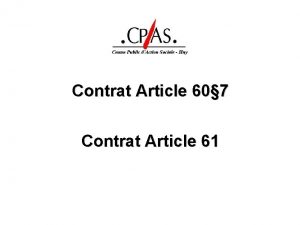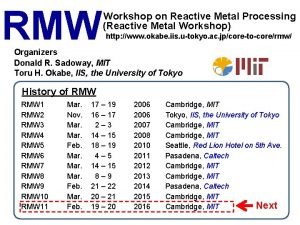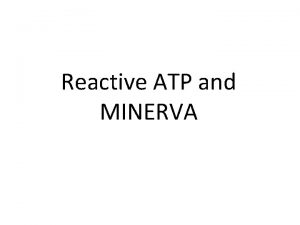Reactive arthritis postinfectious arthritis Reiter disease Reference article


























- Slides: 26

Reactive arthritis, postinfectious arthritis, Reiter disease • Reference: article from Up. To. Date titled Reactive arthritis • Literature review current through: Nov 2017. | This topic last updated: Jul 21, 2016”.

Reactive vs. postinfectious arthritis - 1 • Reactive arthritis is conventionally defined as an arthritis that arises following an infection, although the pathogens cannot be cultured from the affected joints. It is generally regarded as a form of spondyloarthritis. • Reactive arthritis has been defined by consensus as a form of arthritis that is associated with a coexisting or recent antecedent extraarticular infection. • Only certain enteric and genitourinary pathogens are conventionally accepted as capable of causing reactive arthritis. These include Chlamydiatrachomatis, Yersinia, Salmonella, Shigella, Campylobacter, Clostridi um difficile, and Chlamydia pneumoniae. • Various other bacterial and viral infections have been suggested as triggers for postinfectious arthritis but they are by convention not considered as “reactive arthritis. ”

Reactive vs. postinfectious arthritis -2 • Antecedent or concomitant infection — Laboratory tests, such as stool cultures to test for Salmonella, Shigella, Campylobacter, and Yersinia, can sometimes confirm a preceding or concomitant infection with one of the pathogens that classically induce reactive arthritis.

Reactive vs. postinfectious arthritis -3 • An arthritis is conventionally considered to be a reactive arthritis only if it includes a combination of oligoarthritis of peripheral joints, most often with asymmetric involvement of the lower extremity, enthesitis, dactylitis, or inflammatory back pain.

Reactive vs. postinfectious arthritis -4 • Arthritis is a common manifestation in patients with acute rheumatic fever (ARF) following streptococcal pharyngitis. These patients typically lack features common to the spondyloarthritides (eg, enthesitis), and this condition is generally not considered to be a form of reactive arthritis.

Summary/conclusions - Reactive vs. postinfectious arthritis • Reactive arthritis and postinfectious arthritis are not the same and not related by a parent-child relationship because: • Reactive arthritis can start during or after an infection • Reactive arthritis may be associated with dactylitis, enthesitis and inflammatory back pain but not all features may be present at (e. g. only 2090% of patients with reave arthritis present with enthesitis). • Reactive arthritis is considered a kind of spondyloarthrits • Reactive arthritis is usually associated with the following organisms: Chlamydiatrachomatis, Yersinia, Salmonella, Shigella, Campylobacter, Clostridi um difficile, and Chlamydia pneumoniae.

Reactive arthritis vs. Reiter syndrome • The term “reactive arthritis” has sometimes been used historically to refer to the clinical triad of postinfectious arthritis, urethritis, and conjunctivitis, which was formerly called Reiter syndrome. However, these patients represent only a subset of patients with reactive arthritis. • Reasons that the classical triad was formerly called Reiter syndrome. • The presence of the extraarticular manifestations present in the syndrome described by Reiter is inconstant. • The classic symptoms attributed to Reiter were actually reported before Reiter’s description. • A proposal to remove Reiter’s name from the syndrome and which was widely supported by professional medical societies and patient advocacy groups related to the discovery that Hans Reiter was a war criminal. • Reiter syndrome be retained as a synonym both for reactive arthritis and for the classic triad for retrieval purposes.

Proposed models

Infective arthritis

Post-infective arthritis

Spondyloarthritis is an umbrella term for inflammatory diseases that involve both the joints and the entheses (the sites where the ligaments and tendons attach to the bones). The most common of these diseases is ankylosing spondylitis. Others include reactive arthritis, psoriatic arthritis and enteropathic arthritis, which is associated with the inflammatory bowel disease.

Classification of Spondyloarthits • Spondyloarthritis • Axial Spondyloarthritis (predominate involvement of the spine) • Ankylosing spondylitis • Non-radiographic axial spondyloarthritis • Peripheral spondyloarthritis (predominate involvement of the peripheral joints) • Reactive arthritis • Psoriatic arthritis • Peripheral spondyloarthritis related to inflammatory bowel disease

Reactive arthritis • Reactive arthritis is therefore considered to be a peripheral spondyloarthritis due to an antecedent or co-occurrent infection

Spondyloarthritis

Peripheral spondyloarthritis

Axial spondyloarthritis

Reactive arthritis

Ankylosing spondylitis

Non-radiographic axial spondylitis

Reactive arthritis co-occurrent with extrarticular manifestations

Spondyloarthritis co-occurrent with inflammatory bowel disease

Psoriatic arthritis

Reiter disease

Reiter’s urethritis

Spondyloarthritis hierarchy

Final analysis • Proposal addresses difference between Reactive arthritis, Reiter disease and Postinfectious arthritis • Model reorganizes hierarchy based on current view of spondyloarthritides • Model enables specifying extraarticular manifestations as part of a syndrome of which reactive arthritis is a part by using simple cooccurrence pattern
 Sclérite
Sclérite Poststreptococcal reactive arthritis
Poststreptococcal reactive arthritis Reactive arthritis
Reactive arthritis Reactive arthritis pathophysiology
Reactive arthritis pathophysiology Lou reiter
Lou reiter Oliver reiter
Oliver reiter Oliver reiter
Oliver reiter Reiter sendromu triadı
Reiter sendromu triadı Ehud reiter
Ehud reiter Reiter’s syndrome
Reiter’s syndrome Susanne wrighton
Susanne wrighton Reiter’s syndrome
Reiter’s syndrome Balanza con pesas corredizas
Balanza con pesas corredizas Lifecell myco +
Lifecell myco + Keith reiter
Keith reiter Jerry reiter duke
Jerry reiter duke Diana reiter schindler's list
Diana reiter schindler's list Dr pugliese allergist
Dr pugliese allergist Bharathi viswanathan
Bharathi viswanathan What is referencing
What is referencing Reference node and non reference node
Reference node and non reference node Reference node and non reference node
Reference node and non reference node Septic arthritis complications
Septic arthritis complications Septic arthritis antibiotics
Septic arthritis antibiotics Difference between rheumatoid arthritis and osteoarthritis
Difference between rheumatoid arthritis and osteoarthritis Ans
Ans Caplan syndrome
Caplan syndrome

